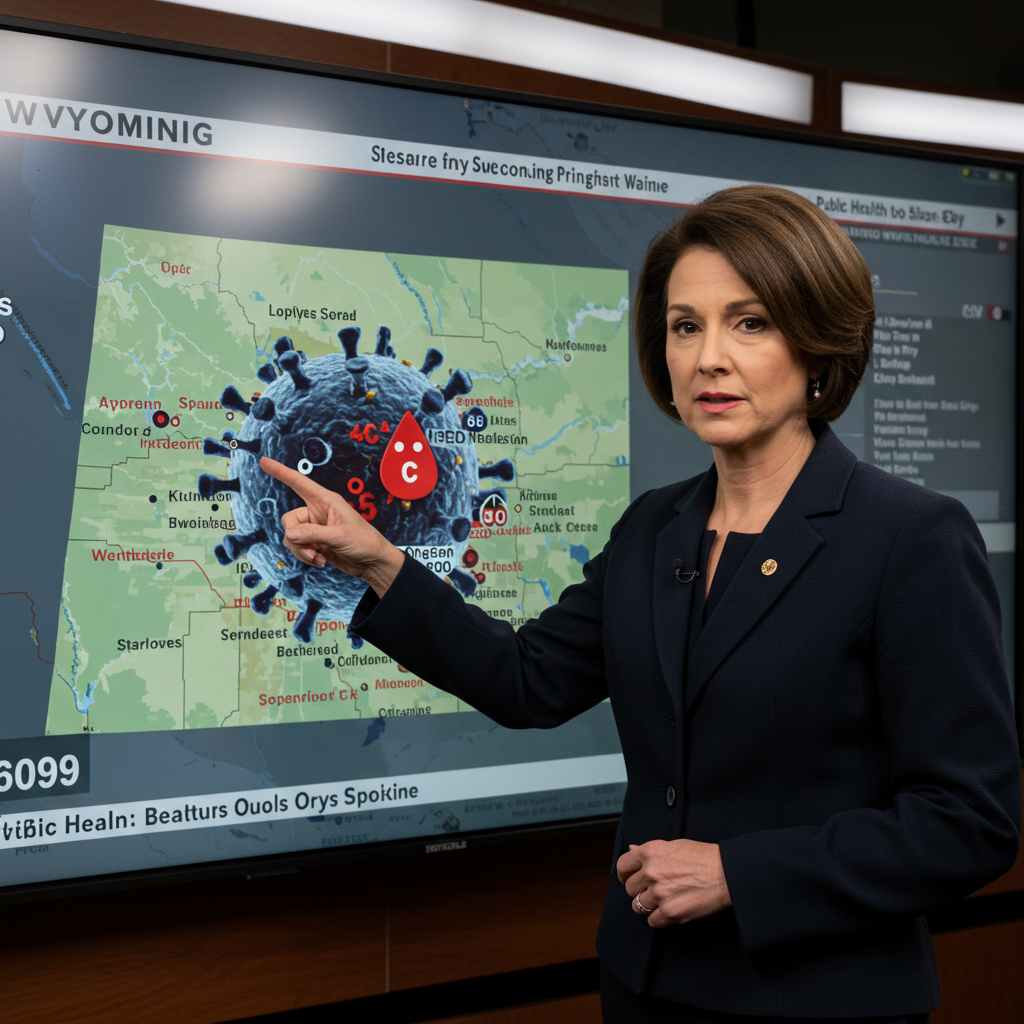Wyoming public health officials have confirmed the state’s first case of measles in 15 years, marking a significant development for public health across the Cowboy State. The case, identified in an unvaccinated child from Natrona County, underscores the ongoing risk of highly contagious diseases in communities with less-than-optimal vaccination rates. This news, confirmed by the Wyoming Health Department (WDH) on Tuesday, July 1st, 2025, has prompted warnings about potential exposure sites and renewed calls for residents to ensure their vaccinations are up to date. The identification of this case follows broader concerns about measles vulnerability in the Mountain West region.
Measles is far more than just a rash. It’s a serious respiratory infection caused by a virus that spreads incredibly easily through the air when an infected person coughs or sneezes. The virus can remain infectious in the air or on surfaces for up to two hours after an infected person leaves an area. Symptoms typically include a high fever, cough, runny nose, and red, watery eyes, followed by a characteristic rash of small, red spots that spreads from the head downwards to the rest of the body. One unique early sign is Koplik’s spots – tiny white spots with bluish-white centers found inside the mouth on the inner lining of the cheek. Measles can lead to severe complications like pneumonia, encephalitis (brain swelling), and even death, particularly in young children, pregnant women, and individuals with weakened immune systems.
Wyoming Confirms First Measles Case in 15 Years
For the first time since 2010, Wyoming has a confirmed case of measles. The Wyoming Health Department announced on Tuesday, July 1, 2025, that an unvaccinated child residing in Natrona County in central Wyoming tested positive for the highly contagious virus. This case ends a notable period of relative immunity for the state and highlights the importance of continued vigilance against vaccine-preventable diseases.
Health officials are actively investigating to determine how the child was exposed to measles. As of the announcement date, the source of the infection had not yet been identified. This points to the challenging nature of contact tracing for a disease that spreads so readily and can travel across states or even internationally. Identifying the origin is crucial for understanding potential chains of transmission and preventing further spread within the community.
Potential Exposure Identified in Casper
The WDH has alerted the public to specific locations where individuals may have been exposed to the measles virus. The unvaccinated child was present in the Emergency Department waiting room at Banner Wyoming Medical Center located in Casper, Wyoming. Potential exposure occurred during two distinct timeframes:
Tuesday, June 24th, 2025, between 11:00 am and 1:00 pm.
Wednesday, June 25th, 2025, from just before 1:00 pm to just before 3:00 pm.
Anyone who was in the Banner Wyoming Medical Center Emergency Department waiting room during these precise hours on June 24th or 25th is considered to have potentially been exposed to the measles virus. The contagious nature of measles means that even brief exposure in a shared space can lead to infection in susceptible individuals. It is critical for individuals who were in this location at these times to be aware of the potential risk and take appropriate steps.
Understanding Wyoming’s Measles Risk
The confirmation of a measles case in Wyoming takes on added significance when viewed in the context of broader public health trends in the Mountain West region. While this is the first case in Wyoming in 15 years, the potential for outbreaks exists, partly due to vaccination rates. Achieving community-wide protection against measles, known as herd immunity, requires approximately 95% of the population to be vaccinated. This high threshold is necessary because measles is so incredibly infectious.
According to data from the Centers for Disease Control and Prevention (CDC) for the 2023-24 school year, the estimated national average vaccination rate for measles, mumps, and rubella (MMR) among kindergarteners was 92.7%. In contrast, the average MMR vaccination rate for kindergarteners across several Mountain West states, including Wyoming, was slightly lower, at just under 90%. While Wyoming’s rate was closer to the national average at 93.5%, it still falls short of the crucial 95% needed for robust community protection. States like Idaho had significantly lower rates, below 80%.
A Local Perspective on Vaccination Trends
A pediatrician based in Casper, Dr. Shelley Springer, has observed a concerning trend locally. She notes an increasing number of families in her practice are choosing not to vaccinate their children against measles. Dr. Springer suggests this decision is often linked to broader lifestyle choices and appears more prevalent in rural, conservative, or religiously oriented communities within the state.
From the perspective of a frontline healthcare provider, Dr. Springer emphasizes that vaccination remains the most effective and safest way to protect children from measles. This is particularly vital for safeguarding those who are most vulnerable, such as infants too young to be vaccinated or individuals who cannot receive the vaccine due to medical conditions. The presence of a confirmed case in Wyoming after such a long period underscores the importance of this public health message and validates concerns raised by local medical professionals.
Measles on the National and Regional Stage
The Wyoming case is not an isolated event. In the year 2025, measles has already infected over 200 people across at least 12 states nationally. Tragically, recent measles outbreaks in other states like New Mexico and Texas have resulted in fatalities, specifically among unvaccinated individuals. These events serve as stark reminders of the potential severity of the disease and the risks faced by those who are unprotected.
The lower regional vaccination rates in the Mountain West, coupled with individual decisions to opt-out of vaccination, create conditions where outbreaks are more likely to occur and spread. The confirmation of a case in Natrona County, Wyoming, despite the state’s relatively higher rate within the region, highlights that no community falling below the 95% threshold is immune to the risk of measles introduction and transmission.
What to Do if You Were Potentially Exposed
If you were present in the Banner Wyoming Medical Center Emergency Department waiting room on Tuesday, June 24th (11 am – 1 pm) or Wednesday, June 25th (just before 1 pm – just before 3 pm), the Wyoming Health Department advises that you monitor yourself for symptoms for 21 days after the potential exposure date. Measles symptoms typically begin 7 to 14 days after exposure, but can take up to 21 days.
It is highly recommended that you check your vaccination records to confirm you have received two doses of the MMR vaccine. Two doses provide approximately 97% protection against measles. If you are unsure of your vaccination status or believe you may not be fully vaccinated, contact your healthcare provider or local public health unit immediately. They can help determine if you need vaccination or other preventative measures, such as immune globulin, which can sometimes prevent or lessen the severity of measles if given within six days of exposure.
If you develop symptoms consistent with measles, it is crucial that you call your healthcare provider before going to their office or an emergency room. This allows them to make arrangements to evaluate you safely without potentially exposing others in the waiting room. Measles is extremely contagious, and taking precautions to avoid spreading the virus to others is a critical public health responsibility.
Frequently Asked Questions
What are the typical signs and symptoms of measles?
Measles is a highly contagious viral illness characterized by a distinct set of symptoms. Initial signs often resemble a common cold and include a high fever (which can spike above 104°F), cough, runny nose, and red, watery eyes. A few days later, small, white spots with bluish centers, known as Koplik’s spots, may appear inside the mouth. The most recognizable symptom is the measles rash, which typically begins as flat, red spots on the face at the hairline and neck, then spreads downward over the body. The rash usually appears about 3-5 days after the first symptoms.
What should I do if I was at Banner Wyoming Medical Center ED waiting room during the specified exposure times?
If you were in the Banner Wyoming Medical Center Emergency Department waiting room in Casper on June 24th (11 am – 1 pm) or June 25th (just before 1 pm – just before 3 pm), the Wyoming Health Department advises you to take immediate action. First, check your vaccination records to confirm you’ve received two doses of the MMR vaccine. If you are unvaccinated, unsure, or immunocompromised, contact your healthcare provider or local health department right away to discuss potential post-exposure options like vaccination or immune globulin. You should also monitor yourself for measles symptoms for 21 days following your exposure date. If symptoms develop, call your doctor before visiting any clinic or hospital to avoid potentially spreading the virus.
Why is the MMR vaccine important for people in Wyoming?
The MMR vaccine is crucial for protecting individuals and the broader community in Wyoming, especially following this confirmed case. Measles is extremely contagious, and vaccination is the most effective way to prevent it. While Wyoming’s kindergarten MMR vaccination rate (93.5%) is relatively high compared to some neighboring states, it still falls below the 95% needed for herd immunity, which protects vulnerable individuals like infants and those unable to be vaccinated. Ensuring high vaccination rates prevents outbreaks, protects the most susceptible populations, and helps maintain Wyoming’s status as a state with low measles incidence, which was recently interrupted by this case.
Conclusion
The confirmed case of measles in Natrona County marks a significant moment for public health in Wyoming, breaking a 15-year streak without the disease. While health officials work to trace the source and prevent further spread, the incident serves as a critical reminder of measles’s contagious nature and potential severity. The situation highlights the importance of maintaining high vaccination rates within the state and region to ensure robust protection against outbreaks. If you were at the potential exposure location in Casper or are unsure about your vaccination status, taking prompt action is the best way to protect yourself, your family, and your community. Staying informed and vaccinated remains the strongest defense against preventable diseases like measles.



